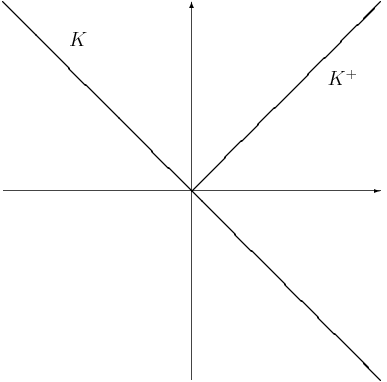Solvency Cone on:
[Wikipedia]
[Google]
[Amazon]
The solvency cone is a concept used in

 Assume there are 2 assets, A and M with 1 to 1 exchange possible.
Assume there are 2 assets, A and M with 1 to 1 exchange possible.
financial mathematics
Mathematical finance, also known as quantitative finance and financial mathematics, is a field of applied mathematics, concerned with mathematical modeling in the Finance#Quantitative_finance, financial field.
In general, there exist two separate ...
which models the possible trades in the financial market
A financial market is a market in which people trade financial securities and derivatives at low transaction costs. Some of the securities include stocks and bonds, raw materials and precious metals, which are known in the financial marke ...
. This is of particular interest to markets with transaction costs
In economics, a transaction cost is a cost incurred when making an economic trade when participating in a market.
The idea that transactions form the basis of economic thinking was introduced by the institutional economist John R. Commons in 1 ...
. Specifically, it is the convex cone
In linear algebra, a cone—sometimes called a linear cone to distinguish it from other sorts of cones—is a subset of a real vector space that is closed under positive scalar multiplication; that is, C is a cone if x\in C implies sx\in C for e ...
of portfolios that can be exchanged to portfolios of non-negative components (including paying of any transaction costs).
Mathematical basis
If given a bid-ask matrix for assets such that and is the number of assets which with any non-negative quantity of them can be "discarded" (traditionally ), then the solvency cone is the convex cone spanned by the unit vectors and the vectors .Definition
A solvency cone is any closed convex cone such that and .Uses
A process of (random) solvency cones is a model of a financial market. This is sometimes called a market process. The negative of a solvency cone is the set of portfolios that can be obtained starting from the zero portfolio. This is intimately related to self-financing portfolios. Thedual cone
Dual cone and polar cone are closely related concepts in convex analysis, a branch of mathematics.
Dual cone
In a vector space
The dual cone ''C'' of a subset ''C'' in a linear space ''X'' over the real numbers, reals, e.g. Euclidean spac ...
of the solvency cone () are the set of prices which would define a friction-less pricing system for the assets that is consistent with the market. This is also called a consistent pricing system.
Examples

 Assume there are 2 assets, A and M with 1 to 1 exchange possible.
Assume there are 2 assets, A and M with 1 to 1 exchange possible.
Frictionless market
In africtionless market In economic theory a frictionless market is a financial market without transaction costs. Friction is a type of market incompleteness. Every complete market is frictionless, but the converse does not hold. In a frictionless market the solvency ...
, we can obviously make (1A,-1M) and (-1A,1M) into non-negative portfolios, therefore . Note that (1,1) is the "price vector."
With transaction costs
Assume further that there is 50% transaction costs for each deal. This means that (1A,-1M) and (-1A,1M) cannot be exchanged into non-negative portfolios. But, (2A,-1M) and (-1A,2M) can be traded into non-negative portfolios. It can be seen that . The dual cone of prices is thus easiest to see in terms of prices of A in terms of M (and similarly done for price of M in terms of A): * someone offers 1A for tM: therefore there is arbitrage if * someone offers tM for 1A: therefore there is arbitrage ifProperties
If a solvency cone : * contains a line, then there is an exchange possible without transaction costs. * , then there is no possible exchange, i.e. the market is completelyilliquid
In business, economics or investment, market liquidity is a market's feature whereby an individual or firm can quickly purchase or sell an asset without causing a drastic change in the asset's price. Liquidity involves the trade-off between the ...
.
References
{{Reflist Financial risk modeling